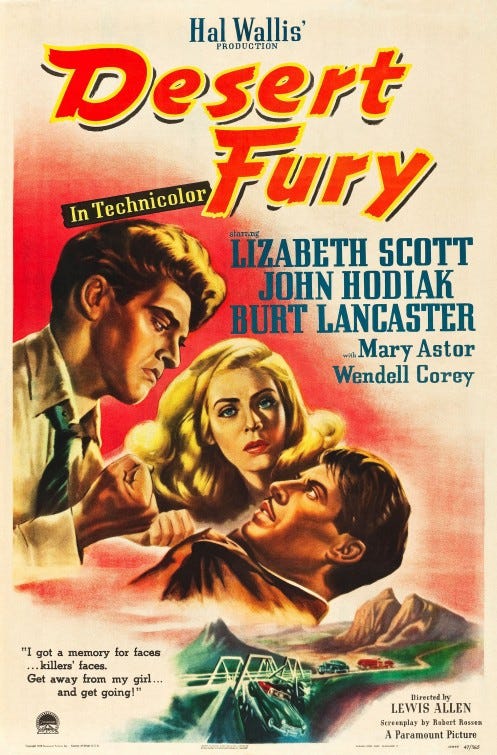'Desert Fury' Review: Sunny Noir
Also: Sylvester Stallone succumbs to superhero-itis in 'Samaritan.'
I love stumbling upon films that surprise and jolt me. Desert Fury did both.
Released in 1947, Desert Fury features crackling dialogue by Robert Rossen and a lurid hothouse atmosphere, courtesy of director Lewis Allen, cinematographers Edward Cronjager and Charles Lang, art director Perry Ferguson, and costume designer Edith Head.
Shot on location in Technicolor, using a single-strip process that was still relatively news, the production looks, primarily, colorful, which fits its setting -- a small town in the wide open spaces of Nevada -- while flying in the face of its darker narrative themes, which identify it as film noir.
Lizabeth Scott, then 25, stars as the 19-year-old Paula Haller, who has just returned home from school Back East. Raised by the strong-willed businesswoman Fritzi Haller (Mary Astor), Paula wants to make her own way in life, but doesn't know what, exactly, she wants to do that will allow her to truly break free from her mother's dominant influence on her life.
Among her business interests locally, Fritzi owns the Purple Sage, a casino and saloon that serves as the heart of Chuckawalla, a fictional community where everybody knows your name. True trouble arrives to town in the person of Eddie Bendix (John Hodiak), who is married (basically) to his best friend and running mate Johnny Ryan (Wendell Corey in his debut role).
Eddie and Fritzi exchange meaningful glances once he arrives in town, which may or may not be related to a shared past of some kind. In any event, Eddie is a criminal figure from New Jersey who is trying to escape accusations that he murdered his wife. Fritzi is trying to escape memories of her deceased husband.
In the opening moments of the film, Eddie and Paula exchanged meaningful glances, even though they hadn't met yet, so that's gotta be resolve. Soon the simmering turns to outright boiling hot love, at least by 1947 standards. Naturally, that will eventually make things explode, especially with Fritzi seething in motherly romantic anger (toward her daughter and her former lover too!) and Johnny seething in jealous romantic anger (toward his "best friend").
There's a lot of simmering and a lot of anger, but you knew that already, because you saw that the film is titled Desert Fury and there's definitely a lot of Desert Fury in the film. Oh, and I forgot to mention that Burt Lancaster has the third-billed role, in support, as a local lawman With A Past Too, so of course he's got a lot of Desert Fury too.
I loved this film, which isn't afraid to play to its pulpy roots. The film is based on "Bitter Harvest," published in 1945, a story by Ramona Stewart, which she later expanded into a novel, Desert Town. The story was optioned by producer Hal B. Wallis; the film was shot on location in Piru (Ventura County), California. Some of the exteriors were shot in Arizona.
John Hodiak is not my fave leading man, but I adore Lizabeth Scott and her honey-coated voice, Mary Astor as a very manly woman who never lets you forget she's a woman, Burt Lancaster standing tall and talking tough, and the sneering Wendell Corey, who absolutely plays a tough man in love to the hilt.
I found the film thanks to The Criterion Channel's "Noir in Color" section, which is highly recommended. Its setting reminded me of another film in the section that I've seen before, Bad Day at Black Rock (1955). The section also furnished the basis for my previous article, "Color Me Desperate," which covered Niagara (1953) and Black Widow (1954). [The Criterion Channel]
When Robert Redford, then 78, appeared in Captain America: The Winter Soldier (2014), I knew the end was near.
Ten years younger, Sylvester Stallone, now 76, appears in Samaritan (2022) as a man haunted by his past. As Joe Smith, he is an ordinary garbage collector and amateur appliance repairman. He prefers a hooded sweatshirt and keeps a low profile in the working-class neighborhood in which he lives, which is not all that different, really, from the neighborhood in which Rocky Balboa burst forth upon the scene in 1976.
One day, Joe is called upon by circumstances to come to the rescue of 13-year-old Sam (Javon "Wanna" Walton), in the process inadvertently revealing his superhuman strength, which confirms to Sam that he, Joe Smith, is actually the long-lost (and presumed dead) superhero Samaritan. Hero-worshiping Sam has been looking for Samaritan for years, stumbling upon one potential (failed) candidate after another, so he rejoices.
Soon, though, a plot must manifest, and this is where Samaritan completely lost my interest. Director Julius Avery previously helmed Overlord (2018), which also had an interesting premise that got bogged down by blood and inertia, and followed a similar throughline of steadily decreasing reasons to keep watching.
Based on an original screenplay by Bragi F. Schut, the story certainly has potential, but quickly falls in line with conventional superhero narratives, as neighborhood gangster Cyrus (Pilou Asbeck) is irresistibly drawn to become a supervillain, simply because that's what every superhero movie needs, a way to pit "good" versus "evil" in the basest manner possible. No doubt due to its limited budget, the visual effects are not terribly convincing. Originally envisioned as a theatrical release, the film now has a more fitting home on a streaming service where many other screening options await. [Prime Video]



